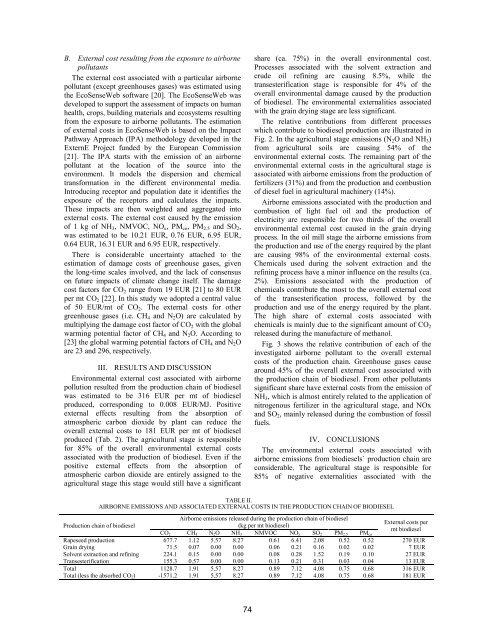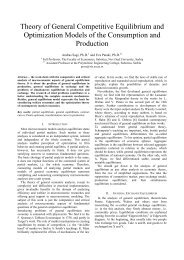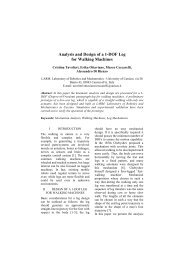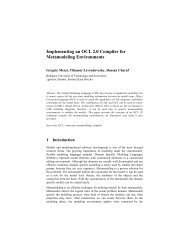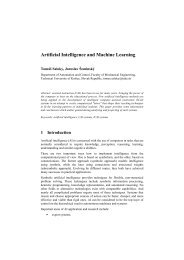Final Program EXPRES 2012 - Conferences
Final Program EXPRES 2012 - Conferences
Final Program EXPRES 2012 - Conferences
- No tags were found...
Create successful ePaper yourself
Turn your PDF publications into a flip-book with our unique Google optimized e-Paper software.
B. External cost resulting from the exposure to airbornepollutantsThe external cost associated with a particular airbornepollutant (except greenhouses gases) was estimated usingthe EcoSenseWeb software [20]. The EcoSenseWeb wasdeveloped to support the assessment of impacts on humanhealth, crops, building materials and ecosystems resultingfrom the exposure to airborne pollutants. The estimationof external costs in EcoSenseWeb is based on the ImpactPathway Approach (IPA) methodology developed in theExternE Project funded by the European Commission[21]. The IPA starts with the emission of an airbornepollutant at the location of the source into theenvironment. It models the dispersion and chemicaltransformation in the different environmental media.Introducing receptor and population date it identifies theexposure of the receptors and calculates the impacts.These impacts are then weighted and aggregated intoexternal costs. The external cost caused by the emissionof 1 kg of NH 3 , NMVOC, NO x , PM co , PM 2.5 and SO 2 ,was estimated to be 10.21 EUR, 0.76 EUR, 6.95 EUR,0.64 EUR, 16.31 EUR and 6.95 EUR, respectively.There is considerable uncertainty attached to theestimation of damage costs of greenhouse gases, giventhe long-time scales involved, and the lack of consensuson future impacts of climate change itself. The damagecost factors for CO 2 range from 19 EUR [21] to 80 EURper mt CO 2 [22]. In this study we adopted a central valueof 50 EUR/mt of CO 2 . The external costs for othergreenhouse gases (i.e. CH 4 and N 2 O) are calculated bymultiplying the damage cost factor of CO 2 with the globalwarming potential factor of CH 4 and N 2 O. According to[23] the global warming potential factors of CH 4 and N 2 Oare 23 and 296, respectively.III. RESULTS AND DISCUSSIONEnvironmental external cost associated with airbornepollution resulted from the production chain of biodieselwas estimated to be 316 EUR per mt of biodieselproduced, corresponding to 0.008 EUR/MJ. Positiveexternal effects resulting from the absorption ofatmospheric carbon dioxide by plant can reduce theoverall external costs to 181 EUR per mt of biodieselproduced (Tab. 2). The agricultural stage is responsiblefor 85% of the overall environmental external costsassociated with the production of biodiesel. Even if thepositive external effects from the absorption ofatmospheric carbon dioxide are entirely assigned to theagricultural stage this stage would still have a significantshare (ca. 75%) in the overall environmental cost.Processes associated with the solvent extraction andcrude oil refining are causing 8.5%, while thetransesterification stage is responsible for 4% of theoverall environmental damage caused by the productionof biodiesel. The environmental externalities associatedwith the grain drying stage are less significant.The relative contributions from different processeswhich contribute to biodiesel production are illustrated inFig. 2. In the agricultural stage emissions (N 2 O and NH 3 )from agricultural soils are causing 54% of theenvironmental external costs. The remaining part of theenvironmental external costs in the agricultural stage isassociated with airborne emissions from the production offertilizers (31%) and from the production and combustionof diesel fuel in agricultural machinery (14%).Airborne emissions associated with the production andcombustion of light fuel oil and the production ofelectricity are responsible for two thirds of the overallenvironmental external cost caused in the grain dryingprocess. In the oil mill stage the airborne emissions fromthe production and use of the energy required by the plantare causing 98% of the environmental external costs.Chemicals used during the solvent extraction and therefining process have a minor influence on the results (ca.2%). Emissions associated with the production ofchemicals contribute the most to the overall external costof the transesterification process, followed by theproduction and use of the energy required by the plant.The high share of external costs associated withchemicals is mainly due to the significant amount of CO 2released during the manufacture of methanol.Fig. 3 shows the relative contribution of each of theinvestigated airborne pollutant to the overall externalcosts of the production chain. Greenhouse gases causearound 45% of the overall external cost associated withthe production chain of biodiesel. From other pollutantssignificant share have external costs from the emission ofNH 3 , which is almost entirely related to the application ofnitrogenous fertilizer in the agricultural stage, and NOxand SO 2 , mainly released during the combustion of fossilfuels.IV. CONCLUSIONSThe environmental external costs associated withairborne emissions from biodiesels` production chain areconsiderable. The agricultural stage is responsible for85% of negative externalities associated with theTABLE II.AIRBORNE EMISSIONS AND ASSOCIATED EXTERNAL COSTS IN THE PRODUCTION CHAIN OF BIODIESELProduction chain of biodieselAirborne emissions released during the production chain of biodieselExternal costs per(kg per mt biodiesel)mt biodieselCO 2 CH 4 N 2O NH 3 NMVOC NO x SO 2 PM 2.5 PM coRapeseed production 677.7 1.12 5.57 8.27 0.61 6.41 2.08 0.52 0.52 270 EURGrain drying 71.5 0.07 0.00 0.00 0.06 0.21 0.16 0.02 0.02 7 EURSolvent extraction and refining 224.1 0.15 0.00 0.00 0.08 0.28 1.52 0.19 0.10 27 EURTransesterification 155.3 0.57 0.00 0.00 0.13 0.21 0.31 0.03 0.04 13 EURTotal 1128.7 1.91 5.57 8.27 0.89 7.12 4.08 0.75 0.68 316 EURTotal (less the absorbed CO 2) -1571.2 1.91 5.57 8.27 0.89 7.12 4.08 0.75 0.68 181 EUR74


